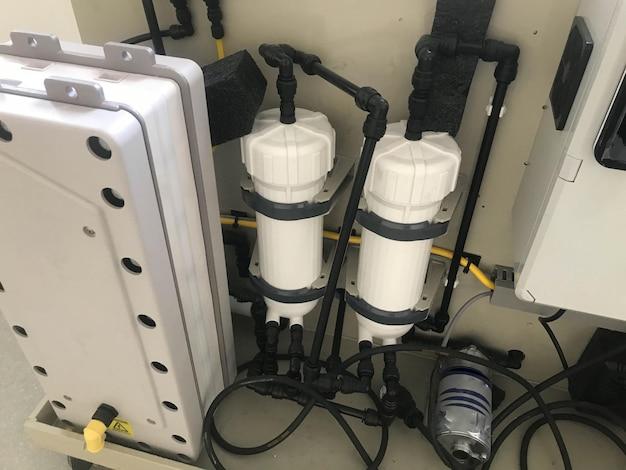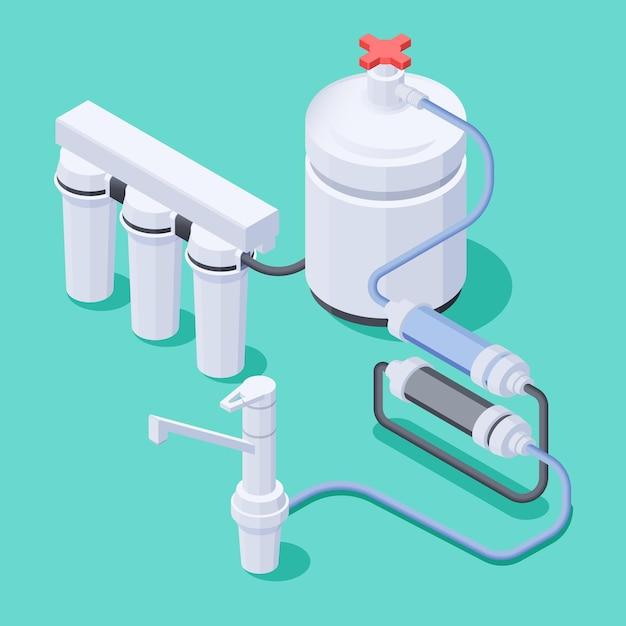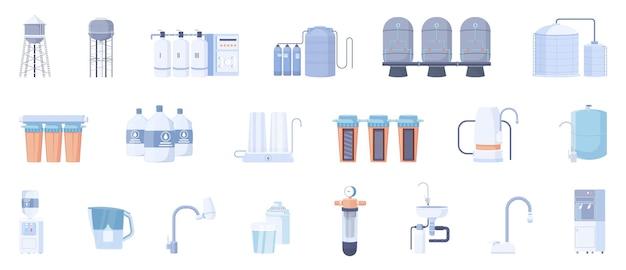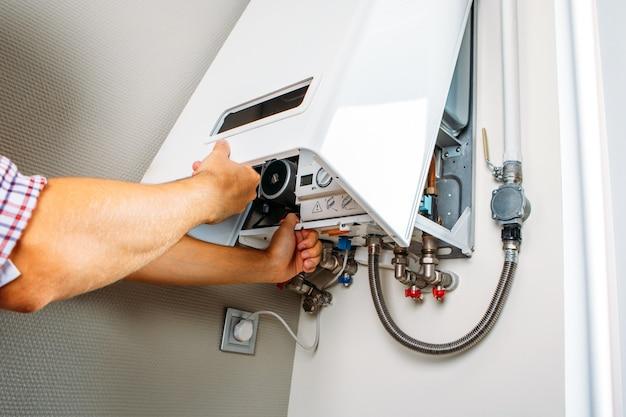Are you wondering if you can install a water softener with a tankless water heater? Well, you’re in the right place. In this blog post, we will guide you through the process of installing a water softener system alongside your tankless water heater. Not only will we explain how tankless water softeners work, but we will also provide you with tips on choosing the best water softener for your tankless water heater setup. Get ready to say goodbye to hard water and hello to a more efficient and enjoyable bathing experience!
How to Install a Water Softener with a Tankless Water Heater
Understanding the Basics
So, you’ve upgraded your old water heater to a shiny new tankless one. Great move! But now you’re wondering how to keep that water soft and snuggly while enjoying the benefits of on-demand hot water. Fear not, dear reader, for I am here to shed light on this conundrum. Let us dive into the world of installing a water softener with a tankless water heater.
Step 1: Assessing the Situation
Before embarking on this adventure, make sure you understand the layout of your plumbing system. Locate the main water supply line and identify where the tankless water heater is installed. This will help you plan the best spot for your water softener.
Step 2: Choosing the Right Water Softener
Now that you’ve got the lay of the land, it’s time to pick a water softener that suits your needs. Look for models that are compatible with tankless water heaters and consider factors like water hardness, capacity, and maintenance requirements. Remember, a water softener can be a loyal companion if chosen wisely!
Step 3: Finding the Perfect Spot
Your water softener needs a cozy home, so find a suitable spot near the main water supply line and the tankless water heater. Make sure there is enough space for installation and future maintenance. Double-check the manufacturer’s instructions for any specific clearance requirements.
Step 4: Shutting off the Water
Before diving into the installation process, shut off the main water supply. We don’t want any unexpected waterworks turning your living room into a swimming pool. Safety first!
Step 5: Plumbing Magic
Connect the water softener to the main water supply line using a bypass valve. This valve will allow you to redirect water flow when necessary, giving you control over when to use the softened water. Pay attention to the directional arrows on the valve and follow the manufacturer’s instructions for proper installation.
Step 6: Keeping Things Leak-Free
Leaky pipes are no fun for anyone. Ensure all connections are tightly secured using appropriate fittings, such as compression or soldering joints. Don’t forget the thread seal tape for those pesky threaded connections. We want a dry and happy installation, after all!
Step 7: Testing, Testing, 1-2-3
Turn on the main water supply and carefully inspect the water softener and its connections for any leaks. Run water through the tankless water heater to ensure everything is functioning as it should. Give yourself a pat on the back if you don’t spot any waterworks drama!
Step 8: Celebrate and Enjoy
Congratulations, my friend! You have successfully installed a water softener with your tankless water heater. Sit back, relax, and revel in the joy of soft water flowing through the warm embrace of your new heater. Cheers to you and your newfound plumbing prowess!
Installing a water softener with a tankless water heater may seem like a daunting task, but with a bit of patience and planning, you can conquer it like a true DIY champion. Remember to follow the manufacturer’s instructions, take safety precautions, and enjoy the benefits of softened water alongside your on-demand hot showers. Happy plumbing adventures!
Water Softener System
Understanding the Importance of a Water Softener System
So you’ve got a tankless water heater, huh? Fancy! But have you ever stopped to think about the kind of water that flows through it? Well, my friend, that’s where a water softener system comes into play. This nifty little device is like a superhero for your home, battling hard water and saving your appliances from the wrath of limescale buildup.
What on Earth is Hard Water
Before we dive into the wonders of water softener systems, let’s first tackle the beast known as hard water. It’s not as tough as it sounds – hard water is simply water that contains high levels of minerals like calcium and magnesium. And why is that a big deal? Well, when these minerals run rampant in your pipes and appliances, they leave behind a chalky residue that can wreak havoc on your beloved tankless water heater. Nobody wants that!
Enter the Water Softener System to the Rescue
Luckily, the water softener system is here to save the day! This magical contraption works by removing those pesky minerals from your water, leaving it soft and gentle on your tankless water heater. It’s like giving your appliance a spa day! With a water softener system, you can say goodbye to limescale buildup and hello to a longer lifespan for your water heater. Who knew maintaining your appliances could be so luxurious?
Choosing the Right Water Softener System for You
Now that you understand the importance of a water softener system, it’s time to find the perfect match for your tankless water heater. There are a few factors to consider, like the size of your household and the water hardness in your area. But fear not, dear reader, for I have some tips to guide you along the way.
-
First things first, determine the size of water softener system you need by calculating your daily water usage. This will ensure that you choose a system with the right capacity to handle your household’s needs.
-
Next, check the grains per gallon (GPG) rating of the water softener system. This will tell you how effective the system is at removing minerals. The higher the GPG rating, the more powerful the system – just like a superhero with an arsenal of superpowers!
-
Don’t forget to consider the regeneration process of the water softener system. Some systems use salt, while others opt for alternative methods. Choose the one that suits your preference and lifestyle.
So there you have it – the wonders of a water softener system for your tankless water heater. It’s like a match made in plumbing heaven! With this trusty sidekick by your side, your tankless water heater will be singing praises, and you’ll be enjoying hot showers and spotless dishes for years to come. Cheers to softer water and happier appliances!
How Do Tankless Water Softeners Work
Introduction
If you’ve ever wondered about the inner workings of a tankless water softener, prepare to have your mind blown (metaphorically, of course). These nifty devices are like magical wizards that turn hard water into soft, silky goodness. But how do they actually achieve this miraculous transformation? Let’s dive in and uncover the secret sauce of tankless water softeners!
Ion Exchange: The Magic Trick
Picture this: you have hard water flowing into your tankless water softener, thinking it’s the boss of the situation. Little does it know, the water softener has an ace up its sleeve – the power of ion exchange. This process starts by welcoming the hard water with open arms, but only to strip away its unwanted minerals, like calcium and magnesium. It’s like a sneaky pickpocket, robbing the water of its hardness and leaving it with shiny, soft goodness.
Resin Beads: The Superheroes
So, how does the tankless water softener pull off this impressive trick? Say hello to its trusty sidekicks – the resin beads! These tiny, sphere-like warriors are loaded with sodium or potassium ions. As the hard water passes through the tankless water softener, the resin beads work their magic. They snatch the calcium and magnesium ions from the water and replace them with the sodium or potassium ions. It’s a sneaky switcheroo that turns hard water into soft water without breaking a sweat.
Regeneration: Recharging for the Next Show
Even the superhero resin beads need to rejuvenate after saving the day. When their sodium or potassium ions run low, it’s time for a little R&R, or in this case, regeneration. The tankless water softener goes through a regeneration cycle, where it flushes out all the captured minerals and reloads the resin beads with fresh ions. Think of it like a well-deserved spa day for your water softener, preparing it to battle hard water once again.
Wrap Up: The Softening Prowess Unveiled
Now you know the secret behind the sorcery of tankless water softeners! Through the power of ion exchange, resin beads, and regeneration cycles, these marvels of modern technology transform hard water into velvety softness. So the next time you enjoy the luxury of a lathered bath or spotless dishes, take a moment to appreciate the unsung heroes lurking within your trusty tankless water softener.
Your Turn to Soften Up
With this newfound knowledge, you’re ready to conquer the world of tankless water softeners! In our next captivating chapter, we’ll explore the installation process, so stay tuned. Until then, embrace the wonders of soft water and bid farewell to those pesky mineral build-ups.
Water Heater and Water Softener Installation
Make way for the ultimate duo!
So, you’ve decided to bring home a tankless water heater and a water softener? Congratulations! You’re about to experience the wonder of hot water without the hassle of limescale buildup. But wait, before you jump in, let’s talk about installing these bad boys.
Step 1: Prep the Stage
Before diving into the installation, turn off the water supply. You don’t want a surprise shower while you’re busy tinkering with pipes. Pro tip: wearing a shower cap might save you from an impromptu redo of your hairstyle.
Step 2: Find the Perfect Spot
Now that you’re in control of the water, it’s time to find the perfect spot for your water heater and water softener. Picture this – a place that is easily accessible, well-ventilated, and isn’t crying out, “Hey, I’m blocking your way!” Remember, harmony is key.
Step 3: Connect the Pipes
Like peanut butter and jelly, your water heater and water softener need to work together seamlessly. Connect the pipes according to the manufacturer’s instructions, but don’t fret if you feel like a plumber who accidentally took a detour into a maze. Take your time, ask for help, and believe in yourself, my DIY warrior!
Step 4: The Finicky Details
With the pipes connected, it’s time to dive into some finicky details. Don’t worry, we’re here to guide you. Adjust the settings on your water softener to match your water hardness level. It’s like teaching a robot to dance – you just need to find the right rhythm. Pro tip: consult the user manual, not your aunt who always breaks into awkward dance moves at weddings.
Step 5: Power On!
Finally, the moment of truth – power on your water heater and water softener. Listen to them hum like a well-rehearsed choir, providing you with the glorious harmony of softened, hot water. And just like that, you’ve made magic happen in your home. Take a bow, my friend. You deserve it!
Installing a water softener alongside a tankless water heater may sound like a daunting task, but fear not, intrepid reader. With a little bit of guidance, a dash of patience, and a sprinkle of humor, you can conquer this project and enjoy the luxurious benefits of softened hot water. So go forth, my DIY champion, and create a haven of relaxation and cleanliness in your humble abode.
Best Water Softener for Tankless Water Heater
Why Soft Water Matters for Your Tankless Water Heater
Using a tankless water heater is a convenient way to ensure you always have hot water on demand. But did you know that hard water can significantly impact the performance and lifespan of your tankless water heater? That’s where a water softener comes into the picture. By removing minerals like calcium and magnesium, a water softener can prevent scale buildup and extend the life of your tankless water heater. So, let’s dive into finding the best water softener for your tankless water heater!
Size Matters: Finding the Perfect Fit
When it comes to finding the best water softener for your tankless water heater, the size of the unit is crucial. You want to make sure the softener can handle the water volume and flow rate required by your tankless system. Talk about a match made in heaven! Look for water softeners specifically designed for tankless water heaters to ensure compatibility and optimal performance.
Smart and Efficient Softening
Who doesn’t want a water softener that’s not only effective but also smart? Smart water softeners use innovative technology to optimize performance and minimize waste. Look for features like automatic regeneration based on water usage, real-time monitoring, and self-cleaning mechanisms. These clever gadgets will ensure your tankless water heater stays happy and your pockets stay full!
Go Salt-Free and Save the Day
Traditional salt-based water softeners are effective but can be a hassle to maintain. If you’re looking for a low-maintenance option, go salt-free! Salt-free water softeners use alternative methods like template-assisted crystallization or magnetic technology to prevent scale buildup without the need for salt. Not only will this save you from lugging heavy bags of salt, but it’s also environmentally friendly. Mother Nature will thank you!
Here’s Our Top Pick
Drum roll, please! Our personal favorite for the best water softener for tankless water heaters is the AquaBliss Water Softener. It’s compact, easy to install, and comes with a smart regeneration system that ensures optimal performance without wasting water. Plus, it’s salt-free and provides excellent scale prevention, saving both your tankless water heater and the environment. It’s a win-win!
So, there you have it. Choosing the right water softener for your tankless water heater doesn’t have to be a daunting task. Remember to consider the size, opt for smart and efficient features, and explore salt-free options like the AquaBliss Water Softener. With the right water softener in place, your tankless water heater will keep providing you with endless hot showers for years to come!
Can You Install a Water Softener with a Tankless Water Heater
So, you’ve got yourself a fancy tankless water heater and you’re feeling pretty smug about it. No more waiting for hot water, no more running out of hot water mid-shower. Life is good. But then, you start hearing about this thing called a water softener. Should you be worried? Can you even install a water softener with a tankless water heater? Let’s find out!
Compatibility Concerns
First things first, let’s address the elephant in the room. Can a water softener and a tankless water heater coexist harmoniously? Well, the good news is that in most cases, they can. You see, a water softener’s main job is to remove minerals, like calcium and magnesium, that can cause limescale buildup on your plumbing fixtures. This limescale buildup can potentially damage your tankless water heater, reducing its efficiency and lifespan. So, installing a water softener can actually be a smart move.
Consult the Manual
Before you start the installation process, it’s always a good idea to consult the manual for both your tankless water heater and the water softener. They might have specific instructions or recommendations for compatibility or installation. Plus, reading manuals is always a fun way to spend your free time, right?
Find the Right Spot
When it’s time to choose the perfect spot for your water softener, make sure you pick a location that is close to your tankless water heater and accessible for maintenance and future repairs. You don’t want to be doing contortionist moves every time you need to check on your equipment. Trust me, it’s not a good look.
Pipe Sizing Matters
Now, let’s talk about pipe sizing. It’s crucial to ensure that your water softener and tankless water heater are connected with appropriately sized pipes. You don’t want to restrict the flow of water or create unnecessary pressure issues. If you’re not sure what pipe size to use, it’s always best to consult a professional plumber. They are like the Sherlock Holmes of pipes, and they’ll make sure everything is perfectly sized and fitted.
Get Hooked Up
Once you’ve found the perfect spot and sorted out the pipe sizing, it’s time to get the water softener hooked up to your tankless water heater. This process usually involves connecting the water softener’s inlet and outlet lines to the correct spots on your tankless water heater. It might sound complicated, but if you follow the included instructions or hire a professional, it should be a walk in the park. Well, maybe not a walk in the park, but more like a leisurely stroll.
Inlet, Outlet, and Drain
When connecting the inlet and outlet lines, it’s essential to pay attention to the proper plumbing connections. You don’t want to accidentally send softened water to your tankless water heater’s inlet or vice versa. And don’t forget about the drain line! The water softener needs a proper drain hookup to flush out all those pesky minerals it collects. Nobody likes a slacker water softener.
The Final Test
Congratulations, you’ve successfully installed a water softener with a tankless water heater! Now, it’s time to put your creation to the test. Turn on your hot water, revel in its newfound softness, and give yourself a pat on the back for a job well done. Just make sure you didn’t accidentally create a hot tub instead of a shower. Unless you’re into that sort of thing.
Wrapping It Up
In conclusion, installing a water softener with a tankless water heater is usually possible and even beneficial for your plumbing system’s long-term health. Just remember to consult the manuals, find the perfect spot, consider pipe sizing, and get everything properly connected. With a little bit of planning and maybe some light reading, you’ll be enjoying the benefits of soft, mineral-free water in no time. Cheers to clean pipes and long showers!



